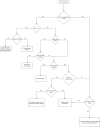Recurrent Hepatocellular Carcinoma: Patterns, Detection, Staging and Treatment
- PMID: 36090786
- PMCID: PMC9450909
- DOI: 10.2147/JHC.S342266
Recurrent Hepatocellular Carcinoma: Patterns, Detection, Staging and Treatment
Abstract
Hepatocellular carcinoma (HCC) is the third most common cause of cancer-related deaths worldwide with the incidence of recurrence being as high as 88% even among patients who have undergone curative-intent treatment. Despite improvements in overall survival, recurrence remains a challenge necessitating accurate reappraisal of patient and disease status. To that end, accurate staging of recurrent HCC is a necessity to provide better care for these patients. Risk factors for poor survival after HCC recurrence have been identified and include characteristics of the primary disease, such as tumor multifocality, large size (≥5 cm), macroscopic vascular or microscopic lymphovascular invasion, preoperative a-fetoprotein (AFP) levels, R0 resection, and the presence of impaired liver function. Close surveillance with imaging is warranted following curative-intent therapy, with magnetic resonance imaging (MRI) being the preferred approach to identify small, early recurrent HCCs. Treatment decisions at the time of recurrence involve ruling out extrahepatic disease and identifying candidates for potentially curative-intent repeat treatment options. Patients with recurrent disease are, however, very diverse in terms of tumor morphology and biologic behavior, as well as residual hepatic functional reserve. Patients with preserved liver function may benefit from repeat liver resection or ablation. Patients with recurrence within the Milan criteria may even be candidates for salvage liver transplantation, while multimodality treatment with combination of liver-directed therapies appears to enhance oncologic outcomes for individuals with advanced recurrent disease. A "one-size-fits-all" approach in staging recurrent HCC does not exist. Rather, individualized and evidence-based decision-making is necessary in order to optimize outcomes for patients with recurrent HCC.
Keywords: classification; hepatocellular carcinoma; recurrence; staging; treatment.
© 2022 Papaconstantinou et al.
Conflict of interest statement
The authors report no conflicts of interest in this work.
Figures
Similar articles
-
Examinations of Factors Influencing Survival of Liver Transplantation for Hepatocellular Carcinoma: A Single-Center Experience From Budapest.Transplant Proc. 2015 Sep;47(7):2201-6. doi: 10.1016/j.transproceed.2015.07.026. Transplant Proc. 2015. PMID: 26361680
-
Prophylactic liver transplantation for high-risk recurrent hepatocellular carcinoma.World J Hepatol. 2016 Nov 8;8(31):1309-1317. doi: 10.4254/wjh.v8.i31.1309. World J Hepatol. 2016. PMID: 27872682 Free PMC article. Review.
-
Multi-disciplinary Concurrent Management of Recurrent Hepatocellular Therapy is Superior to Sequential Therapy.World J Surg. 2017 May;41(5):1331-1339. doi: 10.1007/s00268-016-3844-z. World J Surg. 2017. PMID: 27905019
-
Histological differentiation predicts post-liver transplantation survival time.Clin Res Hepatol Gastroenterol. 2014 Apr;38(2):201-8. doi: 10.1016/j.clinre.2013.11.002. Epub 2013 Dec 30. Clin Res Hepatol Gastroenterol. 2014. PMID: 24388339
-
Surgical treatment for recurrent hepatocellular carcinoma: Current status and challenges.World J Gastrointest Surg. 2023 Apr 27;15(4):544-552. doi: 10.4240/wjgs.v15.i4.544. World J Gastrointest Surg. 2023. PMID: 37206072 Free PMC article. Review.
Cited by
-
Lymph Node Metastasis in Gastrointestinal Carcinomas: A View from a Proteomics Perspective.Curr Oncol. 2024 Aug 2;31(8):4455-4475. doi: 10.3390/curroncol31080333. Curr Oncol. 2024. PMID: 39195316 Free PMC article. Review.
-
Ethnic disparities in the epidemiology, treatment, and outcome of patients with hepatocellular carcinoma in the United States.Hepatoma Res. 2023;9:18. doi: 10.20517/2394-5079.2023.10. Epub 2023 May 18. Hepatoma Res. 2023. PMID: 38371172 Free PMC article.
-
Prognostic significance of the liver stiffness value on magnetic resonance imaging elastography in patients undergoing hepatectomy for hepatocellular carcinoma.Surg Today. 2025 Apr 3. doi: 10.1007/s00595-025-03034-w. Online ahead of print. Surg Today. 2025. PMID: 40178649
-
Preparation and Evaluation of Hepatoma-Targeting Glycyrrhetinic Acid Composite Micelles Loaded with Curcumin.Pharmaceuticals (Basel). 2025 Mar 23;18(4):448. doi: 10.3390/ph18040448. Pharmaceuticals (Basel). 2025. PMID: 40283886 Free PMC article.
-
Effect of multiple peritumoral regions of interest ranges based on computed tomography radiomics for the prediction of early recurrence of hepatocellular carcinoma after resection.Quant Imaging Med Surg. 2023 Oct 1;13(10):6668-6682. doi: 10.21037/qims-23-226. Epub 2023 Sep 4. Quant Imaging Med Surg. 2023. PMID: 37869280 Free PMC article.
References
Publication types
LinkOut - more resources
Full Text Sources


